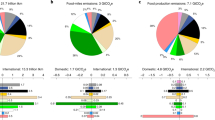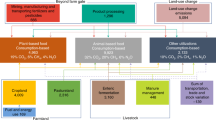Abstract
Despite the importance of animal-based agricultural greenhouse gas emissions as drivers of climate change, the climate costs of such emissions have not yet been quantified in an integrated way. Using a macroeconomic–climate framework, we coupled global agricultural and industrial economies to estimate these costs at a regional level. To be consistent with end-of-century temperature increases of 1.5–3 °C, we found that every 10-percentage-point increase in agricultural emissions required a compensating 1.5-percentage-point reduction in industrial emissions—the ‘emissions opportunity cost’ of animal-based foods. Alternatively, if agricultural emissions were not offset in the industrial sector, diets high in animal protein contributed US$72 per person per year in additional climate damage—approximately half of the annual climate damage produced by the average passenger vehicle in the United States. Our analysis revealed geographic heterogeneity in climate costs by diet and food type, suggesting opportunities for mitigation policies while recognizing food insecurity risks.
This is a preview of subscription content, access via your institution
Access options
Access Nature and 54 other Nature Portfolio journals
Get Nature+, our best-value online-access subscription
$29.99 / 30 days
cancel any time
Subscribe to this journal
Receive 12 digital issues and online access to articles
$119.00 per year
only $9.92 per issue
Buy this article
- Purchase on Springer Link
- Instant access to full article PDF
Prices may be subject to local taxes which are calculated during checkout




Similar content being viewed by others
Data availability
The datasets generated and/or analysed during the current study are archived58 and publicly available on K.K.’s Github website: https://github.com/kevinkuruc/ClimateCostsofAnimalFoods_NatureFood2021.
Code availability
The code used to generate all results is archived58 and available at https://github.com/kevinkuruc/ClimateCostsofAnimalFoods_NatureFood2021.
References
Poore, J. & Nemecek, T. Reducing food’s environmental impacts through producers and consumers. Science 360, 987–992 (2018).
Steinfeld, H. et al. Livestock’s Long Shadow: Environmental Issues and Options (Food and Agriculture Organization of the United Nations (FAO), 2006).
Tubiello, F. N. et al. Agriculture, Forestry and Other Land Use Emissions by Sources and Removals by Sinks: 1990–2011 Analysis (Food and Agriculture Organization of the United Nations (FAO), 2014).
Tilman, D., Balzer, C., Hill, J. & Befort, B. L. Global food demand and the sustainable intensification of agriculture. Proc. Natl Acad. Sci. USA 108, 20260–20264 (2011).
Springmann, M. et al. Options for keeping the food system within environmental limits. Nature 562, 519–525 (2018).
FAOSTAT (Food and Agriculture Organization of the United Nations (FAO), 2020).
Pelletier, N. & Tyedmers, P. Forecasting potential global environmental costs of livestock production 2000–2050. Proc. Natl Acad. Sci. USA 107, 18371–18374 (2010).
Scarborough, P. et al. Dietary greenhouse gas emissions of meat-eaters, fish-eaters, vegetarians and vegans in the UK. Clim. Change 125, 179–192 (2014).
Ripple, W. J. et al. Ruminants, climate change and climate policy. Nat. Clim. Change 4, 2–5 (2014).
Foley, J. A. et al. Solutions for a cultivated planet. Nature 478, 337–342 (2011).
Godfray, H. C. J. et al. Meat consumption, health, and the environment. Science 361, eaam5324 (2018).
Hedenus, F., Wirsenius, S. & Johansson, D. J. A. The importance of reduced meat and dairy consumption for meeting stringent climate change targets. Clim. Change 124, 79–91 (2014).
Bajželj, B. et al. Importance of food-demand management for climate mitigation. Nat. Clim. Change 4, 924–929 (2014).
Springmann, M., Godfray, H. C. J., Rayner, M. & Scarborough, P. Analysis and valuation of the health and climate change cobenefits of dietary change. Proc. Natl Acad. Sci. USA 113, 4146–4151 (2016).
Tilman, D. & Clark, M. Global diets link environmental sustainability and human health. Nature 515, 518–522 (2014).
Pitesky, M. E., Stackhouse, K. R. & Mitloehner, F. M. in Advances in Agronomy Vol. 103 (ed. Sparks, D. L.) 1–40 (Academic Press, 2009).
Herrero, M. et al. Greenhouse gas mitigation potentials in the livestock sector. Nat. Clim. Change 6, 452–461 (2016).
Lamb, A. et al. The potential for land sparing to offset greenhouse gas emissions from agriculture. Nat. Clim. Change 6, 488–492 (2016).
Wirsenius, S., Hedenus, F. & Mohlin, K. Greenhouse gas taxes on animal food products: rationale, tax scheme and climate mitigation effects. Clim. Change 108, 159–184 (2011).
Key, N. & Tallard, G. Mitigating methane emissions from livestock: a global analysis of sectoral policies. Clim. Change 112, 387–414 (2012).
Springmann, M. et al. Mitigation potential and global health impacts from emissions pricing of food commodities. Nat. Clim. Change 7, 69–74 (2017).
Springmann, M. et al. Health-motivated taxes on red and processed meat: modelling study on optimal tax levels and associated health impacts. PLoS ONE 13, e0204139 (2018).
Havlík, P. et al. Climate change mitigation through livestock system transitions. Proc. Natl Acad. Sci. USA 111, 3709–3714 (2014).
The true cost of food. Nat. Food 1, 185 (2020).
National Academies of Sciences, Engineering, and Medicine Valuing Climate Changes: Updating Estimation of the Social Cost of Carbon Dioxide (National Academies Press, 2017).
Addendum to Technical Support Documentation on Social Cost of Carbon for Regulatory Impact Analysis under Executive Order 12866: Application of the Methodology to Estimate the Social Cost of Methane and the Social Cost of Nitrous Oxide (Interagency Working Group on the Social Cost of Carbon, 2016).
Nordhaus, W. D. Revisiting the social cost of carbon. Proc. Natl Acad. Sci. USA 114, 1518–1523 (2017).
Millar, R. J., Nicholls, Z. R., Friedlingstein, P. & Allen, M. R. A modified impulse–response representation of the global near-surface air temperature and atmospheric concentration response to carbon dioxide emissions. Atmos. Chem. Phys. 17, 7213–7228 (2017).
Global Livestock Environmental Assessment Model (Food and Agriculture Organization of the United Nations (FAO), 2018).
Stehfest, E. et al. Climate benefits of changing diet. Clim. Change 95, 83–102 (2009).
Howard, T. & Sterner, T. Raising the Temperature on Food Prices: Climate Change, Food Security, and the Social Cost of Carbon (Agricultural and Applied Economics Association, 2014).
Moore, F. C., Baldos, U., Hertel, T. & Diaz, D. New science of climate change impacts on agriculture implies higher social cost of carbon. Nat. Commun. 8, 1607 (2017).
Havlík, P. et al. Climate Change Impacts and Mitigation in the Developing World: An Integrated Assessment of the Agriculture and Forestry Sectors (World Bank, 2015).
Collins, W. J. et al. Increased importance of methane reduction for a 1.5 degree target. Environ. Res. Lett. 13, 054003 (2018).
Rogelj, J., Meinshausen, M., Schaeffer, M., Knutti, R. & Riahi, K. Impact of short-lived non-CO2 mitigation on carbon budgets for stabilizing global warming. Environ. Res. Lett. 10, 075001 (2015).
Meinshausen, M. RCP Concentration Calculations and Data: Final Version, Background Data, Acknowledgements and Further Info http://www.pik-potsdam.de/~mmalte/rcps/index.htm (2010).
Gerber, P. J. et al. Tackling Climate Change Through Livestock: A Global Assessment of Emissions and Mitigation Opportunities (Food and Agriculture Organization of the United Nations (FAO), 2013).
Greenhouse Gases Equivalencies Calculator—Calculations and References https://www.epa.gov/energy/greenhouse-gases-equivalencies-calculator-calculations-and-references (United States Environmental Protection Agency (EPA), 2019).
Bryngelsson, D., Wirsenius, S., Hedenus, F. & Sonesson, U. How can the EU climate targets be met? A combined analysis of technological and demand-side changes in food and agriculture. Food Policy 59, 152–164 (2016).
Vallgårda, S., Holm, L. & Jensen, J. D. The Danish tax on saturated fat: why it did not survive. Eur. J. Clin. Nutr. 69, 223–226 (2015).
Climate Change: German MPs Want Higher Meat Tax (British Broadcasting Corporation, 2019).
Säll, S. & Gren, I.-M. Effects of an environmental tax on meat and dairy consumption in Sweden. Food Policy 55, 41–53 (2015).
Technical Update of the Social Cost of Carbon for Regulatory Impact Analysis Under Executive Order 12866 (Interagency Working Group on the Social Cost of Carbon, 2016).
Stern, N. H. The Economics of Climate Change: The Stern Review (Cambridge Univ. Press, 2007).
Burke, M., Hsiang, S. M. & Miguel, E. Global non-linear effect of temperature on economic production. Nature 527, 235–239 (2015).
Newbold, T. et al. Global effects of land use on local terrestrial biodiversity. Nature 520, 45–50 (2015).
Foley, J. A. et al. Global consequences of land use. Science 309, 570–574 (2005).
Diaz, R. J. & Rosenberg, R. Spreading dead zones and consequences for marine ecosystems. Science 321, 926–929 (2008).
Wada, Y. et al. Global depletion of groundwater resources. Geophys. Res. Lett. 37, L20402 (2010).
Eshel, G., Shepon, A., Makov, T. & Milo, R. Land, irrigation water, greenhouse gas, and reactive nitrogen burdens of meat, eggs, and dairy production in the United States. Proc. Natl Acad. Sci. USA 111, 11996–12001 (2014).
Delgado, C. L. Rising consumption of meat and milk in developing countries has created a new food revolution. J. Nutr. 133, 3907S–3910S (2003).
Pingali, P. Westernization of Asian diets and the transformation of food systems: implications for research and policy. Food Policy 32, 281–298 (2007).
Caro, D., Davis, S. J., Bastianoni, S. & Caldeira, K. Global and regional trends in greenhouse gas emissions from livestock. Clim. Change 126, 203–216 (2014).
International Consumer and Food Industry Trends (United States Department of Agriculture, 2020).
Frank, S. et al. Reducing greenhouse gas emissions in agriculture without compromising food security? Environ. Res. Lett. 12, 105004 (2017).
Nordhaus, W. D. & Sztorc, P. DICE 2013R: Introduction and User’s Manual (2013).
Smith, C. J. et al. FAIR v1.3: a simple emissions-based impulse response and carbon cycle model. Geosci. Model Dev. 11, 2273–2297 (2018).
Errickson, F., Kuruc, K. & McFadden, J. Animal-based foods have high social and climate costs. Zenodo https://doi.org/10.5281/zenodo.4610542 (2021).
Acknowledgements
We thank D. Anthoff, M. Budolfson and D. Spears for helpful comments on an earlier draft of this manuscript and L. Rennels for coding assistance. This research was supported in part by a grant from the Research Council of the University of Oklahoma. The funders had no role in study design, collection and analysis of data, decision to publish or preparation of the manuscript.
Author information
Authors and Affiliations
Contributions
K.K. designed the research. F.E., K.K. and J.M. performed the research. F.E., K.K. and J.M. analysed the data. F.E., K.K. and J.M. wrote the paper.
Corresponding author
Ethics declarations
Competing interests
The authors declare no competing interests.
Additional information
Peer review information Nature Food thanks Eva Wollenberg and the other, anonymous, reviewer(s) for their contribution to the peer review of this work.
Publisher’s note Springer Nature remains neutral with regard to jurisdictional claims in published maps and institutional affiliations.
Supplementary information
Supplementary Information
Supplementary Tables 1–7, Figs. 1–5 and Discussion.
Supplementary Table 8
Annual per capita protein consumption and household food expenditures.
Rights and permissions
About this article
Cite this article
Errickson, F., Kuruc, K. & McFadden, J. Animal-based foods have high social and climate costs. Nat Food 2, 274–281 (2021). https://doi.org/10.1038/s43016-021-00265-1
Received:
Accepted:
Published:
Issue Date:
DOI: https://doi.org/10.1038/s43016-021-00265-1
This article is cited by
-
Narratives shaping the protein transition
Nature Food (2024)
-
City-level livestock methane emissions in China from 2010 to 2020
Scientific Data (2024)
-
Generation of three-dimensional meat-like tissue from stable pig epiblast stem cells
Nature Communications (2023)
-
Low-carbon diets can reduce global ecological and health costs
Nature Food (2023)
-
Monetizing the externalities of animal agriculture: insights from an inclusive welfare function
Social Choice and Welfare (2023)



